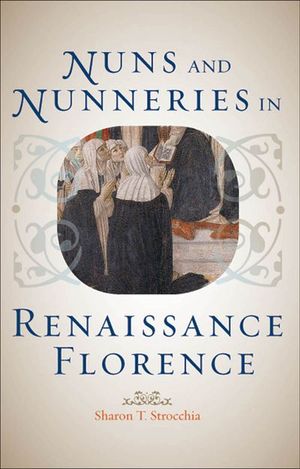Nuns and Nunneries in Renaissance Florence
Published by Johns Hopkins University Press
An analysis of Renaissance Florentine convents and their influence on the city’s social, economic, and political history.
The 15th century was a time of dramatic and decisive change for nuns and nunneries in Florence. That century saw the city’s convents evolve from small, semiautonomous communities to large civic institutions. By 1552, roughly one in eight Florentine women lived in a religious community. Historian Sharon T. Strocchia analyzes this stunning growth of female monasticism, revealing the important roles these women and institutions played in the social, economic, and political history of Renaissance Florence.
It became common practice during this time for unmarried women in elite society to enter convents. This unprecedented concentration of highly educated and well-connected women transformed convents into sites of great patronage and social and political influence. As their economic influence also grew, convents found new ways of supporting themselves; they established schools, produced manuscripts, and manufactured textiles.
Using previously untapped archival materials, Strocchia shows how convents shaped one of the principal cities of Renaissance Europe. She demonstrates the importance of nuns and nunneries to the booming Florentine textile industry and shows the contributions that ordinary nuns made to Florentine life in their roles as scribes, stewards, artisans, teachers, and community leaders. In doing so, Strocchia argues that the ideals and institutions that defined Florence were influenced in great part by the city’s powerful female monastics.
Winner, Helen and Howard R. Marraro Prize, American Catholic Historical Association
“Strocchia examines the complex interrelationships between Florentine nuns and the laity, the secular government, and the religious hierarchy. The author skillfully analyzes extensive archival and printed sources.” —Choice
The 15th century was a time of dramatic and decisive change for nuns and nunneries in Florence. That century saw the city’s convents evolve from small, semiautonomous communities to large civic institutions. By 1552, roughly one in eight Florentine women lived in a religious community. Historian Sharon T. Strocchia analyzes this stunning growth of female monasticism, revealing the important roles these women and institutions played in the social, economic, and political history of Renaissance Florence.
It became common practice during this time for unmarried women in elite society to enter convents. This unprecedented concentration of highly educated and well-connected women transformed convents into sites of great patronage and social and political influence. As their economic influence also grew, convents found new ways of supporting themselves; they established schools, produced manuscripts, and manufactured textiles.
Using previously untapped archival materials, Strocchia shows how convents shaped one of the principal cities of Renaissance Europe. She demonstrates the importance of nuns and nunneries to the booming Florentine textile industry and shows the contributions that ordinary nuns made to Florentine life in their roles as scribes, stewards, artisans, teachers, and community leaders. In doing so, Strocchia argues that the ideals and institutions that defined Florence were influenced in great part by the city’s powerful female monastics.
Winner, Helen and Howard R. Marraro Prize, American Catholic Historical Association
“Strocchia examines the complex interrelationships between Florentine nuns and the laity, the secular government, and the religious hierarchy. The author skillfully analyzes extensive archival and printed sources.” —Choice
BUY NOW FROM
COMMUNITY REVIEWS

